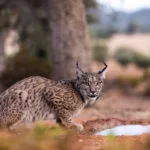
(LONDON) — The Iberian Lynx has rebounded from “endangered” to “vulnerable,” a new study by the International Union for Conservation of Nature (IUCN) announced on Thursday.
The population of the rare wild cat has more than tripled since 2022 — growing from 648 in 2022 to a population estimated to be over 2,000 today, according to estimations by the IUCN.
Conservationists say it is the “greatest recovery” of a cat species ever achieved through conservation, the rebound coming following a two-decade-long conservation push.
“The significant recovery of the Iberian lynx demonstrates that even the most threatened species can be brought back from the brink of extinction,” Sarah Durant, Professor at Zoological Society of London’s Institute of Zoology says in a statement sent to ABC News.
One major factor that scientists believe contributed to the dwindling Iberian lynx population is an at risk food supply.
Its main prey, the European rabbit, joined the lynx on the IUCN red list in 2008, being classified as near threatened but in 2018, they became officially classified as endangered. Their appearance on this list is due to consistent disease outbreaks within the rabbit population and, to combat the lynxes extinction, extensive efforts have been made focused on restoring the rabbit population on the Iberian Peninsula.
Secondary threats to both the lynx and the rabbits come from environmental degradation in their natural habitat, scientists say.
The IUCN says over 400 Iberian lynx have been reintroduced to parts of Portugal and Spain, with the wild cats occupying at least 3,320 square kilometers (1,281 square miles) today, an exponential increase from 449 square kilometers in 2005.
The Iberian lynx, also known as lynx pardinus, is a wild cat commonly found in southwestern Europe and the Mediterranean forests of the Iberian Peninsula.
The rare cats are known for their characteristic pointed ears and spotted fur and Francisco Javier Salcedo Ortiz, Coordinator of the LIFE Lynx-Connect project, has called their rebound the “greatest recovery of a cat species ever achieved through conservation”
“This success is the result of committed collaboration between public bodies, scientific institutions, NGOs, private companies, and community members including local landowners, farmers, gamekeepers and hunters, and the financial and logistical support of the European Union LIFE project,” said Ortiz.
“Through committed, science-based conservation action and provides hope for those working to protect wildlife across the globe,” Durant said.
Copyright © 2024, ABC Audio. All rights reserved.
